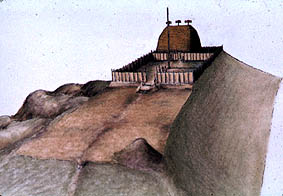
Temple and/or priest-chief's house on Monks Mound.
Ridge-topped mounds are also interpreted as boundary markers for Cahokia because Powell (Mound 86) and Rattlesnake mounds (Mounds 64 and 66) are located on the periphery of the main mound concentration. Other mounds may have served as markers or lines of site from Monks Mound for certain celestial events. Finally, it is likely that many larger mounds, often assumed to be the temple mounds, also served to elevate the residence of an elite family.
Without a doubt, more detailed information on the construction sequence and function of more mounds would significantly improve our understanding of socio-political and religious aspects of American Bottom Mississippian society and culture. Melvin Fowler's recent work (Fowler 1998) at Mound 72 amply illustrates the rich story of Mississippian people that lies in American Bottom Mounds.